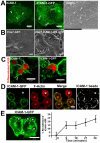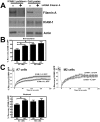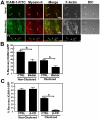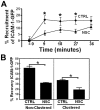Inside-out regulation of ICAM-1 dynamics in TNF-alpha-activated endothelium
- PMID: 20596527
- PMCID: PMC2893160
- DOI: 10.1371/journal.pone.0011336
Inside-out regulation of ICAM-1 dynamics in TNF-alpha-activated endothelium
Abstract
Background: During transendothelial migration, leukocytes use adhesion molecules, such as ICAM-1, to adhere to the endothelium. ICAM-1 is a dynamic molecule that is localized in the apical membrane of the endothelium and clusters upon binding to leukocytes. However, not much is known about the regulation of ICAM-1 clustering and whether membrane dynamics are linked to the ability of ICAM-1 to cluster and bind leukocyte integrins. Therefore, we studied the dynamics of endothelial ICAM-1 under non-clustered and clustered conditions.
Principal findings: Detailed scanning electron and fluorescent microscopy showed that the apical surface of endothelial cells constitutively forms small filopodia-like protrusions that are positive for ICAM-1 and freely move within the lateral plane of the membrane. Clustering of ICAM-1, using anti-ICAM-1 antibody-coated beads, efficiently and rapidly recruits ICAM-1. Using fluorescence recovery after photo-bleaching (FRAP), we found that clustering increased the immobile fraction of ICAM-1, compared to non-clustered ICAM-1. This shift required the intracellular portion of ICAM-1. Moreover, biochemical assays showed that ICAM-1 clustering recruited beta-actin and filamin. Cytochalasin B, which interferes with actin polymerization, delayed the clustering of ICAM-1. In addition, we could show that cytochalasin B decreased the immobile fraction of clustered ICAM-1-GFP, but had no effect on non-clustered ICAM-1. Also, the motor protein myosin-II is recruited to ICAM-1 adhesion sites and its inhibition increased the immobile fraction of both non-clustered and clustered ICAM-1. Finally, blocking Rac1 activation, the formation of lipid rafts, myosin-II activity or actin polymerization, but not Src, reduced the adhesive function of ICAM-1, tested under physiological flow conditions.
Conclusions: Together, these findings indicate that ICAM-1 clustering is regulated in an inside-out fashion through the actin cytoskeleton. Overall, these data indicate that signaling events within the endothelium are required for efficient ICAM-1-mediated leukocyte adhesion.
Conflict of interest statement
Figures










References
-
- Kluger MS. Vascular endothelial cell adhesion and signaling during leukocyte recruitment. Adv.Dermatol. 2004;20:163–201. - PubMed
-
- van Buul JD, Kanters E, Hordijk PL. Endothelial signaling by Ig-like cell adhesion molecules. Arterioscler Thromb Vasc Biol. 2007;27:1870–1876. - PubMed
-
- Vestweber D. Molecular mechanisms that control leukocyte extravasation through endothelial cell contacts. Ernst Schering Found Symp Proc. 2007;3:151–167. - PubMed
Publication types
MeSH terms
Substances
LinkOut - more resources
Full Text Sources
Other Literature Sources
Research Materials
Miscellaneous

